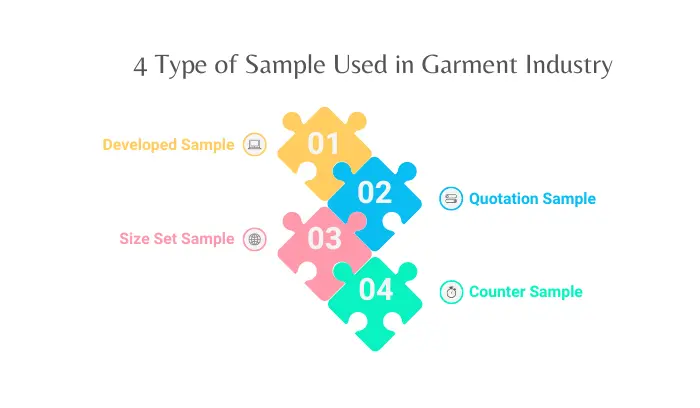Definition Type of Sample
A small amount of things that represent a large population is referred to as a sample of those things. That sample references product details, such as color specifications, Measurement, Fabric composition, trims, and accessories.
Importance of Samples in the Garments Industry
Samples play a crucial role in ensuring quality control, meeting customer expectations, and streamlining production processes in the garments industry. By allowing manufacturers to visualize and test various aspects of a garment before mass production, samples contribute to the overall efficiency.

Different Types of Samples Used in the Garments Industry
- Developed Sample
- Quotation Sample
- Size Set Sample
- Counter Sample
Developed Sample
Sometimes, the sample section prepares samples for buyers according to the direction of the product development merchandiser team to provide buyers with Developed samples. Any available materials with properties similar to the fabric may be used to prepare a developed model.
- Definition and Purpose: A developed sample, also known as a pre-production sample, is created after the proto sample is approved. It is a refined version of the proto sample, incorporating any necessary adjustments or modifications based on feedback and further development.
- Key Features: Developed samples showcase the finalized design, construction, and garment details. They are used for final evaluation before mass production begins.
- Importance in Production Process: Developed samples ensure that all design elements are accurately represented and any issues identified in the proto-sample stage have been addressed.
Quotation Sample
A fitness test quotation sample (using a dummy) is prepared according to the buyer’s requirements. Almost all the specified materials are used for quotation samples (Color, Fabric type, GSM, etc.)
- Definition and Purpose: A quotation sample, called a cost sample, is created specifically for cost estimation purposes. For pricing purposes, it accurately represents the garment’s design and specifications.
- Key Features: Quotation samples focus on presenting the essential aspects of the garment, such as fabric type, construction methods, and embellishments, to facilitate accurate cost calculation.
- Importance in Pricing: Quotation samples help manufacturers and clients determine the cost of producing the garment, considering factors like materials, labor, and overhead expenses.
Size Set Sample
Size set sampling includes 2 samples of each size, made with the fabric and finishing intended for the final product. After this, mass production can start once the brand approves the factories. All the buyers’ recommended materials are used, and all the sizes are delivered for this sample.
- Definition and Purpose: A size set sample is produced to verify the sizing and proportions of the garment across different sizes within a specific range. It allows manufacturers to ensure consistency in fit across various body types.
- Key Features: Size set samples include garments in multiple sizes, typically ranging from the smallest to the largest available sizes. They are used for fit evaluation and adjustments to achieve uniformity across all sizes.
- Importance in Sizing: Size set samples play a crucial role in ensuring that the garment fits a range of body shapes and sizes, effectively meeting the target market’s needs.
Counter Sample
A counter sample is a factory’s first sample for a production order. This sample checks a factory’s sewing quality, ability to interpret technical packages, and ability to achieve the required garment specifications. All the materials, trimmings, and accessories are attached to this sample per the buyer’s requirements. In every line, the counter sample is hung on.
- Definition and Purpose: A counter sample, or a duplicate sample, is created to replicate an existing sample provided by the client or reference. It serves as a benchmark for manufacturers to match the original sample’s design, quality, and specifications.
- Key Features: Counter samples closely resemble the original in design, materials, and construction. They are used for production reference to ensure consistency with the client’s requirements.
- Importance in Replication: Counter samples are essential for accurately reproducing a specific design or style requested by the client. They enable manufacturers to replicate the desired product with precision and fidelity.
Conclusion
Samples are indispensable tools in the garments industry, serving multiple purposes, from design validation to quality assurance and sales promotion. The different types of samples and their respective roles is essential for ensuring efficiency and success in garment manufacturing. Buyers often require manufacturers to produce fabric, dyeing, printing, and stitching costs for a specific style or pattern. Also, manufacturers must create a garment operation bulletin sheet or an SMV. Depending on the buyer’s requirements. 4 types of samples are crucial parts of the process before starting bulk production.
Read More: 10 Different Types of Samples Use in Garments Industry
FAQs (Frequently Asked Questions)
What are the different types of samples in manufacturing?
There are 4 types of samples used in the garment industry
1. Developed Sample
2. Quotation Sample
3. Size Set Sample
4. Counter Sample
What are samples in clothing?
In the clothing industry, samples refer to prototypes or trial versions of garments created during design and development. These samples are used for various purposes, including evaluating design concepts, testing fabric and construction techniques, assessing fit and sizing, and showcasing the final product to clients or buyers.
Which sample type is used to fit a garment?
The sample type used specifically for fitting a garment is called a “Fit Sample.” This sample is created during the product development process to assess a garment’s fit, comfort, and overall wearability before it goes into mass production.


